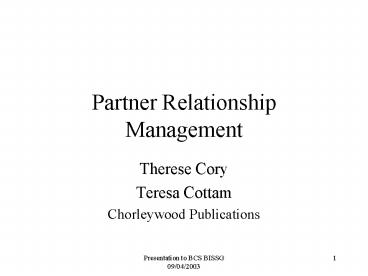Partner Relationship Management - PowerPoint PPT Presentation
1 / 22
Title:
Partner Relationship Management
Description:
... to partner - or do it yourself. employee skills. available ... Lessons learned from failed data warehousing, CRM and other large projects. 18. CISCO Ecosystem ... – PowerPoint PPT presentation
Number of Views:3861
Avg rating:3.0/5.0
Title: Partner Relationship Management
1
Partner Relationship Management
- Therese Cory
- Teresa Cottam
- Chorleywood Publications
2
What is PRM?
- What is a partnership
- definition of partners people who get together
to achieve a common purpose - the deeper the alliance, the greater value-add
the partners can generate between them - greater
potential for profitability, new growth
opportunities. - partner to deliver product Together reach NEW
markets neither could reach otherwise. - Large companies becoming a collection of
collaborators - collaborative enterprise..
Customer focused - process centric, partner
dependent. extending the boundaries of the
enterprise.
3
Types of partnership
- ranges from flirtation / short term relationship/
....marriage - one project / loose reseller arrangement../
value-add / joint venture ... permanent -
acquisition/merger! - Failure gets more costly.. Lucent-Alcatel merger
did not materialise. - Different types of partnership necessitate
different strategies
4
(No Transcript)
5
Comparison of depth of alliances
6
When to partner - or do it yourself
- employee skills
- available assets
- superior processes
- cost
- differentiated offering
- protected niche..
- Partnering creates a larger virtual organisation,
more advantageous to capturing market share.
Business goals and information must be shared.
Primary provider may reduce working capital, some
of this carried by partners.
7
Reducing strategic and business uncertainties
- How do the business objectives of the
participants mesh with one another? - Is there a size/power differential?
- Is the relationship a business-to-business or
supplier-to-buyer one? - Are the participants sharing a common business
goal, or simply links in a supply chain? - Are some partners likely to put their own
immediate needs first? - What information do participants need to
understand their partners better? - How will working with new partners assist /
create new problems for participants? - Could differences in work habits and culture
endanger partner management? - Does the contract provide for an exit strategy?
8
Once the decision to partner is made...
- Decide what type of partnership is appropriate
- Select best approach - management and operations
- Identify skills needed
- Identify data needed
- Some solutions are people intensive, others
depend heavily on IT
9
The Roots of PRM
- Methodologies with business focus
- supply chain management, value stream creation
- Information management
- document management, CALS
- Software
- groupware, concurrent engineering
- ALL DEPEND ON
- data management, networking, storage
10
People and Data
- Information in peoples heads or on bits of paper
- Estimated that 80 of a companys knowledge is
not written down at all - 16 is available on computers but is unstructured
(e-mails, ppt presentations) - 4 is in structured form, analysable, shareable
(database, information systems)
11
So what is PRM?
- A new market sector, promising huge revenue
growth - A management concept, good practice, business
processes, all supported by IT - Wide range of product types and solutions
- AT ITS MOST STRATEGIC, PRM IS A MISSION CRITICAL
TOOL
12
Management reducing operational uncertainties
- What functions must be performed by each partner?
- What information do they need and when?
- Are all processes understood, including human
roles? - Need mechanisms to
- measure criteria for success/ascertain
performance - remunerate partners
13
Examples of product concepts
- Intranet/extranet with shared tools
- Extension of supply chain
- Extension of CRM
- Closed e-marketplace/private exchange
- Electronic bonding
- BUT..You cannot automate a partnership, only
support it!
14
Examples of commercial software products - ALLEGIS
- Shared extranet built around a database
- Range of shared applications and tools
- Role-based access permission/security
- Workflow and activity management
- OLAP reporting
15
Tools to support function
- Finding and recruiting partners - risk
management, profiling, on-line registration - Motivating and managing - training and
certification, joint business planning, market
development funds, lead management - Supporting joint sales and marketing - on-line
product catalogues, targeted communications,
searchable knowledge base, pricing - Assessing performance and success - ROI,
analytics, customer feedback, SLAs - Accounting and remuneration tools
16
Other product examples
- Supply chain extension - PeopleSoft
- CRM extension - Siebel
- Private exchange - Webridge
- People productivity and data management -
Intraspect - Electronic bonding - PartnerCommunity
17
Critical success factors
- Usability!
- Language and currency support
- Links to legacy systems
- Supporting best practice, not enforcing new
practices - Lessons learned from failed data warehousing, CRM
and other large projects
18
CISCO Ecosystem
- Example of partner matrix
- Two tier reseller structure
- Developed in-house with aid of consultants
- In EMEA, 90 of products are sold through
channel, 10 through direct salesforce - Emphasis on increasing partner skills
- Partners have same tools as salesforce
19
Telecoms industry - New imperatives
- New types of partnerships and partners
- Participants contrasted in business, culture,
size - New revenue sharing models, e.g.
- MVNO
- ordering bandwidth if you are an ISP
- ordering a local loop from the incumbent
20
(No Transcript)
21
Example Bureau Service/Outsourcing
- Applies to billing, mediation, interconnect
- Alternative to software licensing
- Revenues more predictable for suppliers
- Enforces ongoing supplier/customer interaction
- Strict SLA criteria/risk sharing
22
Example Peering between ISPs(example from
William Norton, Equinix)
- Decide on case for peering
- Identify counterpart
- Contact and qualification
- Discussion and negotiation
- Business case and Decision
- BUT..
- It could all fail because of personality clash!































